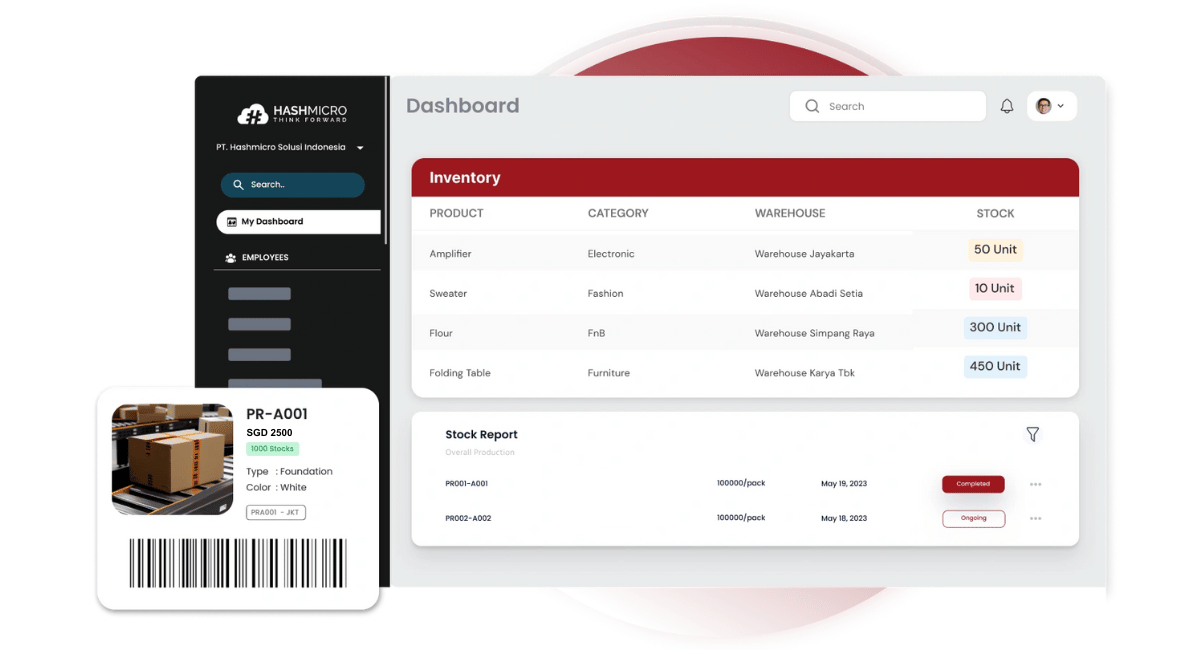Are you struggling to maintain the right amount of inventory for your business? Do you find yourself constantly dealing with overstocking or understocking issues? If you’re a business owner in Singapore, you’re not alone. Poor inventory management is among the top reasons why small businesses fail.
However, with the right inventory control tips, you can strike the right balance between having too little or too much inventory, reduce costs, improve cash flow, and boost your business’s bottom line
In this article, we’ll provide you with some essential inventory control tips to help you manage your inventory more effectively.

Table of Content:
Table of Content
Key Takeaways
|
1. Categorize Your Inventory
Check out your inventory. There must be items that need more attention than others. Therefore, you should not treat all of your inventory the same way.
Using the ABC technique is the easiest way to categorize your stock of goods, commonly known as the supply chain management system. Items in category A require the most attention since their financial impact is quite significant although sales are unpredictable.
Items in category C require less attention, because they have a smaller financial impact, despite the high frequency of sales. Meanwhile, goods in category B fall somewhere in between.
2. Determine Your Minimum Stock Levels
Make inventory control easier by setting up minimum stock levels for each product. This will make it easier for you to replenish your stocks and prevent shortages.
Minimum stock levels can get determined based on how quickly an item sells and how long it takes to get it back from your supplier. Make sure your procurement team oversees stock levels regularly so that replenishment can get done on time.
Note: With an inventory management system, you can receive low-stock alerts whenever your items reach predetermined minimum levels. Thus, your procurement team won’t have to keep an eye on your inventory levels at all times.
3. Use Integrated Inventory Control Software
There is no more effective way to optimize inventory control than using an automated inventory solution. Not only does an inventory management system help you optimize stock levels, but also allows you to forecast inventory needs, monitor stock movements from one warehouse to another, track shipments, carry out inventory valuations, and a lot more.
For optimal efficiency, consider choosing an inventory management system that can integrate with other systems such as sales management and accounting system. This will make it easier for you to keep inventory costs under control so that you can significantly save costs and easily manage your purchases.
To explore a comprehensive inventory management system with flexible pricing schemes, click on the banner below to learn more about HashMicro’s offerings.
4. Store Your Items Properly
One of the main causes of inventory damage and spoilage is improper storage. It can also complicate the picking process. Therefore, it is important for you to provide suitable storage rooms for your items.
Make sure the temperature in each storage room is well controlled so that perishable items like food do not get damaged quickly. Check the condition of your racks and make sure there are no termites that can damage your items. Do not put too much stuff in one rack to prevent items from overlapping or rubbing against each other.
You can put your high-selling items in the front storage area or in an easily accessible aisle so your staff can easily pick them up and move them to a packaging or shipping area. As for your low-selling items, you can put them in the rear storage area.
5. Implement FIFO & FEFO Techniques
To reduce the risk of damage or spoilage, consider implementing First-In-First-Out (FIFO) and First-Expired-First-Out (FEFO) techniques. FIFO means prioritizing your oldest items to be sold first, while FEFO means prioritizing the items with the deadline for the next intake to be sold first (perfect for food and drug products).
In addition to reducing waste, both FIFO and FEFO techniques also help optimize inventory turnover which ultimately helps increase your business revenue and profits.
6. Optimize Your Inventory Replenishment
You also need to analyze the performance of your suppliers during this time. You can ask questions and examine some questions, including:
- Do they always manage to fulfill your demand in a timely manner?
- Are they always contactable?
- Is the quality of their products always good?
In addition to assessing the supplier’s performance, you should also assess your performance as a buyer. Analysis of the following points:
- Do you always pay your bills on time?
- Are the purchase orders (PO) that you sent complete and clear?
- Do you always read your suppliers’ quotations thoroughly?
To make it easier for you to smoothen stock replenishment, consider using HashMicro e-procurement software. With this software, you can automatically create POs, requests for quotations (RFQs), and purchase agreements. You can also maintain all your suppliers’ details and view your transaction history with them. You can even allow them to submit their RFQs and invoices by themselves through a supplier portal.
7. Perform Inventory Audits Regularly
Although in most cases, you have been (or will be) relying on software, it is still important to perform stocktaking to ensure the reconciliation between the physical amount of inventory and your accounting data.
Cycle counting with more frequent schedules will make it easier for you to minimize errors or any discrepancies between the on-hand inventory and computer data. Unlike full physical inventory, cycle counting does not require extra time and energy since it can be done anytime.
With an Inventory Management System, you won’t need to check your stocks manually by writing them down on paper. You can record your stock availability using a barcode inventory management program that is integrated with the system. Duplicate entries can be identified so that errors can be minimized. In essence, inventory audits can be performed quickly, easily, and accurately with the help of an automated inventory solution.
8. Increase Security
To mitigate inventory shrinkage in your Singapore warehouse, it is imperative to bolster security measures and implement tailored strategies to address the local context. Enhancing warehouse security is paramount, and this can be achieved by ensuring a secure entrance and exit, installing an alarm system, and maintaining well-lit premises.
In the Singaporean context, where the logistics industry is a key economic driver, the importance of safeguarding inventory is heightened due to the city-state’s role as a regional hub for trade and commerce.
Issuing access cards to staff responsible for inventory management is essential to monitor and restrict access. This practice aligns with Singapore’s emphasis on efficiency and accountability in business operations.
Furthermore, the installation of CCTV cameras in every aisle of the warehouse is crucial, given Singapore’s commitment to leveraging technology for security and surveillance. The city-state is known for its advanced infrastructure and smart city initiatives, making it an ideal environment to integrate cutting-edge security solutions.
9. Implement Cross-docking
Cross-docking is a logistics strategy that can help businesses in Singapore reduce storage time and costs while speeding up the shipping process.
This approach involves minimal or no storage of goods, as inbound materials are sorted and consolidated before being immediately loaded onto outbound trucks for shipment to specific locations.
By eliminating the need for long-term storage, cross-docking can help businesses reduce inventory holding costs and improve supply chain efficiency.
In Singapore, where the logistics industry is a key contributor to the economy, cross-docking can be particularly beneficial due to the city-state’s strategic location as a regional hub for trade and commerce.
With its advanced infrastructure and connectivity, Singapore is well-positioned to leverage cross-docking to streamline logistics operations and enhance competitiveness.
To implement cross-docking, businesses can sort inbound materials based on their destination and consolidate them into staging areas or directly onto outbound trucks. This requires careful planning and coordination to ensure that the right materials are loaded onto the right trucks and shipped to the correct locations.
In addition, businesses may need to invest in technology and equipment to support cross-docking operations, such as conveyor systems, automated sorting machines, and real-time tracking and monitoring systems.
10. Staff Training
Staff responsible for inventory management in warehouses should be well-trained and knowledgeable about warehouse regulations to ensure efficient and secure operations. Conducting staff training is crucial to equip employees with the necessary skills and expertise to manage inventory effectively.
Introduce staff to the inventory management system used by your company, such as warehouse management systems (WMS) or warehouse control systems (WCS), which help track and manage inventory in real-time.
Monitor their performance and encourage them to provide feedback to improve human resource management. This approach aligns with Singapore’s commitment to continuous learning and development, as well as its reputation for high-quality education and training.
By investing in staff training and development, businesses in Singapore can enhance their inventory management capabilities and maintain a competitive edge in the global market. This focus on employee development is also in line with Singapore’s efforts to foster a skilled workforce and promote economic growth.
Conclusion
Inventory control in inventory management is maximizing inventory levels to ensure that the company has enough inventory to meet the number of customer orders on time. For businesses, inventory management helps with more accurate inventory calculation, decision-making, depreciation control, and full fulfillment of customer orders.
To make inventory management easier for your business, use HashMicro’s Inventory Management Software. With an excellent integrated system, manage it fully from monitoring the amount of stock in the warehouse in real-time to scheduled stock settings if it is running out. Our IMS system is fully integrated with various modules such as Accounting System, Purchasing System, to CRM-Sales System. Schedule a free demo now to experience the transformational power it brings to your operations.

FAQ About Inventory Control
Why is inventory control important for businesses?
Inventory control is essential as it ensures businesses maintain optimal stock levels, reducing the risk of overstocking or understocking. Proper control enhances cash flow, minimizes storage costs, and boosts operational efficiency.How can businesses categorize their inventory effectively?
Businesses can use the ABC technique, categorizing inventory into A, B, and C groups based on sales frequency and financial impact. Group A contains high-impact items, Group C includes low-impact items, and Group B lies in between.What role does inventory management software play in effective control?
Inventory management software automates inventory processes, offering real-time monitoring, forecasting, and integration with sales and accounting systems. It streamlines stock optimization and procurement, improving overall control.What practices enhance inventory storage efficiency?
Proper storage practices involve maintaining suitable environmental conditions, organizing stock to prevent damage or spoilage, implementing FIFO (First-In-First-Out) and FEFO (First-Expired-First-Out) techniques, and strategically positioning high-selling items for easier access.How can businesses ensure accurate inventory counts and audits?
Regular inventory audits, aided by inventory management software and barcode systems, help maintain accuracy. Cycle counting, a method of continuous counting rather than full physical inventory, minimizes discrepancies and errors in inventory tracking.





















